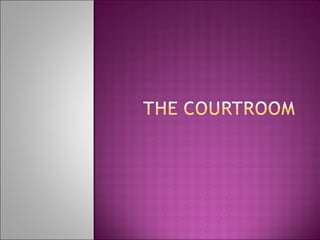The Courtroom
- 1. ?
- 2. Manages the courtroom, ensuring that order is maintained. Makes rulings on evidence issues. Listens Makes the decision in some cases.
- 3. Represents the crown. Is responsible for ensuring the justice happens. Their job is not simply to just seek a conviction.
- 4. Hired by the accused or the government Is there to represent the accused. Must ensure that the accusedĄŊs rights are protected.
- 5. Listens to the case. Comes to a consensus decision on the guilt or innocence of the accused.
- 6. Procedure Arraignment Bail Hearing Preliminary Hearing The Trial
- 7. ?
- 8. The Trial Motions Jury Selection Arraignment/Rearraignment Presentation of Evidence Jury or Judge Verdict Sentence
- 9. Presentation of Evidence Crown starts with examination-in-chief of witness Defence may cross-examine witness Crown may reexamine witness Defence may recross-examine with judgeĄŊs permission Defence presents evidence Crown may cross-examine witness Defence may reexamine witness Crown may make rebuttal Defence may make surrebuttal
- 10. Presentation of Evidence When the witness is yours, you may not ask leading questions, since witnesses are pre-examined by their side Cross-examinations may use leading questions Credibility is important for all witnesses Evidence must be presented through witnesses (expert or non-expert) If the defence raises a new matter, the crown may give evidence in reply (rebuttal) and then the defence may present surrebuttal (evidence to counter the crownĄŊs rebuttal evidence)










